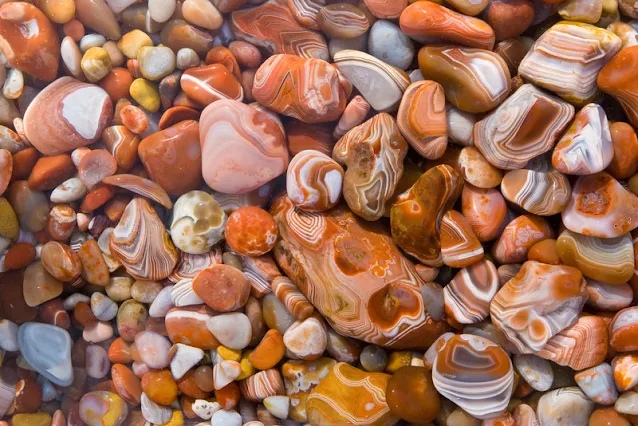Lake Superior Agate: Where Can You Find It
Lake Superior Agate
The Lake Superior agate is a type of agate stained by iron and found on the shores of Lake Superior.
The Lake Superior agate differs from other agates found around the world in its rich red, orange, and yellow coloring. This color scheme is caused by the oxidation of iron. Iron leached from rocks provided the pigment that gives the gemstone its beautiful array of color. The concentration of iron and the amount of oxidation determine the color within or between an agate's bands.
 |
| What is Lake Superior Agate, and Where Can You Find It. Lake Superior agate. Photo: TheAgateDude.com |
The gemstone comes in various sizes. The gas pockets in which the agates formed were primarily small, about 1 cm in diameter. A few Lake Superior agates have been found that are 22 cm in diameter with a mass exceeding 10 kilograms. Very large agates are extremely rare.
 |
| Lake Superior agate |
Geologic History
The lava flows formed the conditions for creation of Lake Superior agates. As the lava solidified, water vapor and carbon dioxide trapped within the solidified flows formed a vesicular texture (literally millions of small bubbles). Later, groundwater transported ferric iron, silica, and other dissolved minerals passed through the trapped gas vesicles. These quartz-rich groundwater solutions deposited concentric bands of fine-grained quartz called chalcedony, or embedded agates.
Over the next billion years, erosion exposed a number of the quartz-filled, banded vesicles—agates—were freed by running water and chemical disintegration of the lavas, since these vesicles were now harder than the lava rocks that contained them. The vast majority, however, remained lodged in the lava flows until the next major geologic event that changed them and Minnesota.
Where to Find Lake Superior Agate
Lake Superior agates, known for their vibrant colors and intricate patterns, are primarily found along the shores of Lake Superior, particularly in the states of Minnesota, Wisconsin, and Michigan. The gemstone's formation process, linked to ancient volcanic activity, has resulted in deposits of agate pebbles and nodules along the lake's shoreline.
Here are some specific locations where Lake Superior agates can be found:
Minnesota: Minnesota's North Shore, stretching from Duluth to Grand Portage, is a renowned spot for agate hunting. Beaches like Brighton Beach, Split Rock Bay State Park, and Burlington Bay are known for their agate yields.
Wisconsin: Wisconsin's Chequamegon Bay, near Ashland, offers a rich source of Lake Superior agates. Agate collectors frequent beaches like Chequamegon Point State Park and Little Girl's Point Beach for their abundance of agate treasures.
Michigan: Michigan's Upper Peninsula, particularly the Keweenaw Peninsula, is a promising area for agate hunting. Beaches like McLouth Beach, Black Rocks Beach, and Agate Falls State Park are known for their agate deposits.
 |
| A pile of rough Lake Superior agates |
How to Find a Lake Superior Agate
You have decided to hunt for Lake Superior agates, but how do you know what to look for? There is no simple answer. Usually, the richly colored banding pattern is not well exposed and prospectors must look for other clues to the presence of agates.
The following characteristics will help you identify agates in the field.
Band planes along which the agate has broken are sometimes visible, giving the rock a peeled texture. It appears as though the bands were partially peeled off like a banana skin.
Iron-oxide staining is found on nearly all agates to some degree, and generally covers much of the rock. Such staining can be many different colors, but the most common are shades of rust-red and yellow.
Translucence is an optical feature produced by chalcedony quartz, the principal constituent of agates. The quartz allows light to penetrate, producing a glow. Sunny days are best for observing translucence.
A glossy, waxy appearance, especially on a chipped or broken surface, is another clue.
A pitted texture often covers the rock surface. The pits are the result of knobs or projections from an initial layer of softer mineral matter deposited on the wall of the cavity in which the agate formed. Later, when the quartz that formed the agate was deposited in the cavity, these projections left impressions on the exterior.
Read Also:
What is Petoskey stone, and Where Can You Find It?
What is Sea Glass, and Where Can You Find It?

%20(1).webp)






